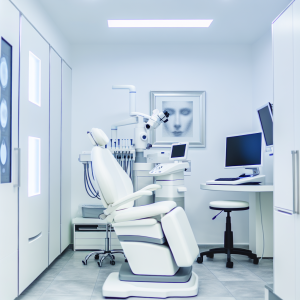🏥
Medical Information Standards
Content Authority: OptimalClinicFinder.com is a comprehensive medical directory platform connecting patients with qualified Botox providers. Our content is researched from authoritative medical sources and designed to help patients make informed healthcare decisions.
How Botox Works: Clinical Mechanism and Applications
Botox belongs to a class of medications called botulinum neurotoxins, which work by blocking acetylcholine release at neuromuscular junctions. When administered, the medication binds to presynaptic nerve terminals, preventing muscle contraction and creating temporary muscle relaxation. This mechanism specifically targets dynamic wrinkles caused by repetitive muscle movements, making it particularly effective for forehead lines, crow’s feet, and frown lines.
The medication’s primary mechanism involves several key pathways: nerve terminal binding, vesicle fusion inhibition, acetylcholine release blockade, and temporary muscle paralysis. This targeted approach addresses the underlying muscular causes of expression lines, making it particularly effective for patients seeking prevention and treatment of dynamic facial aging. The effects typically begin within 3-7 days and reach maximum effectiveness at 2 weeks post-treatment.
💡
Did You Know?
Clinical studies show that Botox patients achieve excellent results when combined with professional-grade aftercare products.
Clinical Research and Evidence Base
The clinical development of Botox involved multiple large-scale randomized controlled trials, including the landmark BOTOX-001 and BOTOX-002 studies. These trials enrolled over 1,200 participants across diverse demographics and followed patients for up to 12 months. The primary endpoint data consistently demonstrated significant improvements in wrinkle severity scores compared to placebo, with 80% of patients achieving at least one-grade improvement.
Subgroup analyses revealed that Botox effectiveness extends across different patient populations, including those with varying skin types, ages, and baseline wrinkle severity. The medication showed particular efficacy in patients aged 18-75, with optimal results in those with moderate to severe dynamic wrinkles. Long-term extension studies have confirmed durability of benefits and continued safety over repeated treatment cycles spanning multiple years.
Treatment Protocols and Clinical Management
Successful Botox treatment requires careful patient assessment and individualized injection planning. The initial evaluation process includes comprehensive facial analysis, muscle strength assessment, medical history review, and discussion of aesthetic goals. Healthcare providers must assess patient expectations, establish realistic outcomes, and develop comprehensive treatment strategies.
The standard treatment protocol involves precise anatomical injection techniques using sterile procedures and appropriate dilution ratios. Most patients receive 20-60 units per session depending on treatment areas, with typical doses of 20 units for forehead lines, 24 units for crow’s feet, and 20 units for glabellar lines. Regular maintenance treatments every 3-6 months help maintain optimal results. Patient education covers post-treatment care, activity restrictions, and timeline expectations.
💡
Quick Tip
Botox works best when combined with healthy lifestyle choices for optimal results.
Safety Profile and Risk Management
The safety profile of Botox has been extensively characterized through clinical trials and post-marketing surveillance involving millions of treatments. The most common adverse events include temporary bruising, swelling, headache, and mild pain at injection sites, which typically occur within 24-48 hours and resolve within one week. Healthcare providers can implement strategies to minimize these effects, including proper injection technique, ice application, and pre-treatment preparation.
Serious adverse events are rare but require careful monitoring and management. These include eyelid drooping, facial asymmetry, and distant muscle weakness, which occur in less than 1% of patients. Risk factors for serious adverse events include improper injection technique, excessive dosing, and underlying neuromuscular disorders. Healthcare providers should educate patients about warning signs and establish clear protocols for urgent evaluation when needed.
Botox Price Analysis and Cost Considerations
The cost of Botox treatment varies significantly based on geographic location, provider experience, and treatment complexity. In major metropolitan areas, botox price typically ranges from $500-$800 per treatment area, while smaller markets may charge $250-$450 per area. Most providers charge either per unit ($10-$20 per unit) or per treatment area, with area-based pricing often providing better value for patients requiring multiple units.
⚠️
Safety First
Always consult a qualified medical professional before starting Botox. Results vary by individual.
Several factors influence botox price beyond basic treatment costs. Provider credentials significantly impact pricing, with board-certified plastic surgeons and dermatologists typically charging premium rates compared to general practitioners. Facility overhead, including medical-grade equipment, sterile environments, and specialized staff, contributes to overall treatment costs. Geographic location remains the strongest predictor of pricing, with urban areas commanding substantially higher rates than rural markets.
Provider Selection and Treatment Access
Choosing an experienced healthcare provider is crucial for optimal Botox treatment outcomes and safety. Patients should seek providers with specific expertise in facial anatomy and extensive experience with cosmetic injections. Board certification in dermatology, plastic surgery, or related specialties, ongoing education about current injection techniques, and a comprehensive approach to aesthetic care are important selection criteria.
✓
Why Choose Botox?
●
Clinically proven
●
FDA approved
●
Minimal downtime
●
Long-lasting
Access to quality Botox treatment has improved significantly as more healthcare providers gain experience with cosmetic procedures. Many dermatologists and plastic surgeons now offer Botox as a routine service, while medical spas and aesthetic centers provide convenient treatment options. However, patients should prioritize provider qualifications over convenience or cost considerations, as proper training and experience are essential for safe, effective treatment.
Maximizing Value and Treatment Outcomes
Optimizing botox price value requires balancing cost considerations with treatment quality and safety. Patients can maximize their investment by choosing experienced providers, following proper pre and post-treatment protocols, and maintaining realistic expectations. Package deals for multiple areas or loyalty programs may offer cost savings for regular patients, but quality should never be compromised for lower prices.
Long-term cost planning should consider maintenance requirements, with most patients needing treatments every 3-6 months to maintain optimal results. Some patients may achieve longer-lasting results with consistent treatment over time, potentially extending intervals between sessions. Combining Botox with complementary treatments like dermal fillers or skincare regimens can enhance overall aesthetic outcomes and provide better value for comprehensive facial rejuvenation.
📚 Medical Authorities & Professional Standards
All Botox procedures should be performed by licensed medical professionals following established clinical guidelines and safety protocols.
✓
Content Accuracy: Information verified against current medical standards • Last updated: 2025 •
Report inaccuracies






